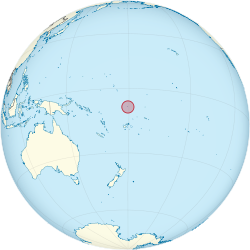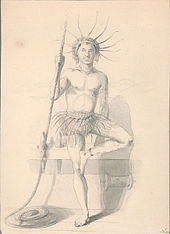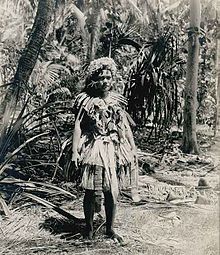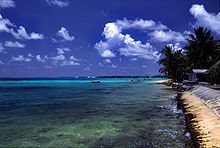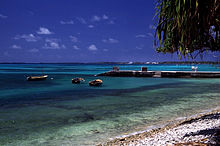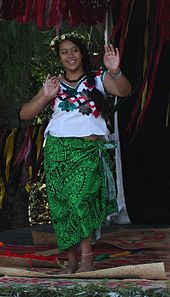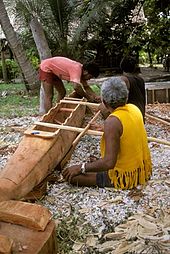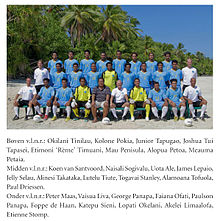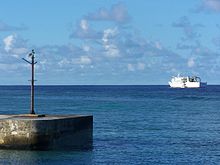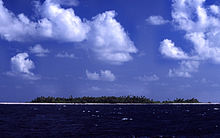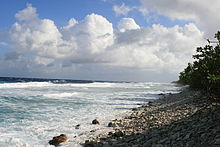
Tuvalu
Did you know...
SOS Children has tried to make Wikipedia content more accessible by this schools selection. SOS Children has looked after children in Africa for forty years. Can you help their work in Africa?
|
Tuvalu
|
||||||
|---|---|---|---|---|---|---|
|
||||||
| Motto: "Tuvalu mo te Atua" ( Tuvaluan) "Tuvalu for the Almighty" |
||||||
| Anthem: Tuvalu mo te Atua (Tuvaluan) Tuvalu for the Almighty Royal anthem: God Save the Queen |
||||||
|
|
||||||
| Capital | Funafuti 8°31′S 179°13′E |
|||||
| Official languages |
|
|||||
| Ethnic groups |
|
|||||
| Demonym | Tuvaluan | |||||
| Government | Parliamentary democracy under constitutional monarchy | |||||
| - | Monarch | Elizabeth II | ||||
| - | Governor General | Iakoba Italeli | ||||
| - | Prime Minister | Willy Telavi | ||||
| Legislature | Parliament | |||||
| Independence | ||||||
| - | from the United Kingdom | 1 October 1978 | ||||
| Area | ||||||
| - | Total | 26 km2 ( 226th) 10 sq mi |
||||
| - | Water (%) | negligible | ||||
| Population | ||||||
| - | July 2011 estimate | 10,544 ( 224th) | ||||
| - | Density | 475.88/km2 ( 22nd) 1,142/sq mi |
||||
| GDP ( PPP) | 2010 (est.) estimate | |||||
| - | Total | $36 million ( 223rd) | ||||
| - | Per capita | $3,400 (2010 est.) ( 164th) | ||||
| Currency |
AUD) |
|||||
| Time zone | ( UTC+12) | |||||
| Drives on the | left | |||||
| Calling code | +688 | |||||
| ISO 3166 code | TV | |||||
| Internet TLD | .tv | |||||
Tuvalu ( / t uː ˈ v ɑː l uː / too-VAH-loo or / ˈ t uː v əl uː / TOO-və-loo), formerly known as the Ellice Islands, is a Polynesian island nation located in the Pacific Ocean, midway between Hawaii and Australia. It comprises three reef islands and six true atolls spread out from 6° to 10° south. Its nearest neighbours are Kiribati, Nauru, Samoa and Fiji. Its population of 10,544 makes it the third-least populous sovereign state in the world, with only Vatican City and Nauru having fewer inhabitants. In terms of physical land size, at just 26 square kilometres (10 sq mi) Tuvalu is the fourth smallest country in the world, larger only than the Vatican City at 0.44 km2 (0.17 sq mi), Monaco at 1.98 km2 (0.76 sq mi) and Nauru at 21 km2 (8.1 sq mi).
The first inhabitants of Tuvalu were Polynesian people. In 1568 Spanish navigator Álvaro de Mendaña sailed through the islands and is understood to have sighted Nui during his expedition in search of Terra Australis. In 1819 the island of Funafuti was named Ellice's Island; the name Ellice was applied to all nine islands after the work of English hydrographer Alexander George Findlay (1812–1876). The islands came under Britain's sphere of influence in the late 19th century, when the Ellice Islands were declared a British protectorate by Captain Gibson R.N., of HMS Curacao, between 9 and 16 October 1892. The Ellice Islands were administered as British protectorate by a Resident Commissioner from 1892 to 1916 as part of the British Western Pacific Territories (BWPT), and later as part of the Gilbert and Ellice Islands colony from 1916 to 1974.
A referendum was held in December 1974 to determine whether the Gilbert Islands and Ellice Islands should each have their own administration. As a consequence of the Ellice Islands self-determination referendum, 1974 the Gilbert and Ellice Islands colony ceased to exist on 1 January 1976 and the separate British colonies of Kiribati and Tuvalu came into existence. Tuvalu became fully independent within the Commonwealth on 1 October 1978. On 5 September 2000, Tuvalu became the 189th member of the United Nations.
History of Tuvalu
Pre-History and History
The first inhabitants of Tuvalu were Polynesians. Therefore the origins of the people of Tuvalu are addressed in the theories regarding the spread of humans out of Southeast Asia, from Taiwan, via Melanesia and across the Pacific islands to create Polynesia. During pre-European-contact times there was frequent canoe voyaging between the nearer islands including Tonga and Samoa. Eight of the nine islands of Tuvalu were inhabited; thus the name, Tuvalu, means "eight standing together" in Tuvaluan. Possible evidence of fire in the Caves of Nanumanga may indicate human occupation for thousands of years.
An important creation myth of the islands of Tuvalu is the story of the Eel and the Flounder; the Flounder reminding the Tuvaluans of the flat atolls. The stories as to the ancestors of the Tuvaluans vary from island to island. On Niutao, Funafuti and Vaitupu the founding ancestor is described as being from Samoa; whereas on Nanumea the founding ancestor is described as being from Tonga.
Tuvalu was first sighted by Europeans on 16 January 1568 during the voyage of Álvaro de Mendaña de Neira from Spain who is understood to have sighted the island of Nui, which he named Isla de Jesus (Island of Jesus), however Mendaña was unable to land. During Mendaña's second voyage across the Pacific he passed Niulakita on 29 August 1595, which atoll he named La Solitaria. Captain John Byron passed through the islands of Tuvalu in 1764 during his circumnavigation of the globe as captain of HMS Dolphin. Byron charted the atolls as Lagoon Islands.
Keith S. Chambers and Doug Munro (1980) identify Niutao as the island that Francisco Antonio Mourelle sailed past on 5 May 1781, thus solving what Europeans had called The Mystery of Gran Cocal. Mourelle's map and journal named the island El Gran Cocal ('The Great Coconut Plantation'); however, the latitude and longitude was uncertain. Longitude could only be reckoned crudely as accurate chronometers were unavailable until the late 18th century.
The next European to visit was Arent Schuyler de Peyster, of York, captain of the armed brigantine or privateer Rebecca, sailing under British colours, which passed through the southern Tuvaluan waters in May 1819; de Peyster sighted Nukufetau and Funafuti, which he named Ellice's Island after an English Politician, Edward Ellice, the Member of Parliament for Coventry and the owner of the Rebecca's cargo. In 1820 the Russian explorer Mikhail Lazarev visited Nukufetau as commander of the Mirny.
Whalers began roving the Pacific, although visiting Tuvalu only infrequently because of the difficulties of landing on the atolls. No settlements were established by the whalers. Captain George Barrett of the Nantucket whaler Independence II has been identified as the first whaler to hunt the waters around Tuvalu. In November 1821 he bartered coconuts from the people of Nukulaelae and also visited Niulakita. Louis Isidor Duperrey, captain of the Coquille, sailed past Nanumanga in May 1824 during a French Government expedition.
For less than a year between 1862–63, Peruvian ships, engaged in what became to be called the " blackbirding" trade, combed the smaller islands of Polynesia from Easter Island in the eastern Pacific to Tuvalu and the southern atolls of the Gilbert Islands (now Kiribati), seeking recruits to fill the extreme labour shortage in Peru. While some islanders were voluntary recruits the "blackbirders" were notorious for enticing islanders on to ships with tricks, such as pretending to be Christian missionaries, as well as kidnapping islanders at gun point. The Rev. A. W. Murray, the earliest European missionary in Tuvalu, reported that in 1863 about 180 people were taken from Funafuti and about 200 were taken from Nukulaelae as there were fewer than 100 of the 300 recorded in 1861 as living on Nukulaelae.
Christianity first came to Tuvalu in 1861 when Elekana, a deacon of a Congregational church in Manihiki, Cook Islands became caught in a storm and drifted for 8 weeks before landing at Nukulaelae on the 10th of May 1861. Elekana began proselytising Christianity. He was trained at Malua Theological College, a London Missionary Society school in Samoa, before beginning his work in establishing the Church of Tuvalu. In 1865 the Rev. A. W. Murray of the London Missionary Society – a Protestant congregationalist missionary society – arrived as the first European missionary where he too proselytized among the inhabitants of Tuvalu. By 1878 the Church of Tuvalu was well established with preachers on each island. In the later 19th Century and early 20th century the ministers of what became the Church of Tuvalu were predominantly Samoans, who influenced the development of the Tuvaluan language and the music of Tuvalu.
Trading firms and traders
Trading companies became active in Tuvalu in the mid-nineteenth century; the trading companies engaged palagi traders who lived on the islands. Some islands would have competing traders while dryer islands might only have a single trader. Louis Becke, who later found success as a writer, was a trader on Nanumanga from April 1880 until the trading-station was destroyed later that year in a cyclone. He then became a trader on Nukufetau. In 1892, Captain Davis of the HMS Royalist, reported on trading activities and traders on each of the islands visited. Captain Davis identified the following traders in the Ellice Group: Edmund Duffy ( Nanumea); Jack Buckland ( Niutao); Harry Nitz ( Vaitupu); John (also known as Jack) O'Brien ( Funafuti); Alfred Restieaux and Emile Fenisot ( Nukufetau); and Martin Kleis ( Nui). During this time, the greatest number of palagi traders lived on the atolls, acting as agents for the trading companies.
In the later 1890s and into first decade of the 20th century, structural changes occurred in the operation of the Pacific trading companies; trading companies moved from a practice of having traders resident on each island to instead becoming a business operation where the supercargo (the cargo manager of a trading ship) would deal directly with the islanders when a ship visited an island. From 1900, the numbers of palagi traders in Tuvalu declined with the last of the palagi traders being Fred Whibley on Niutao and Alfred Restieaux on Nukufetau. By 1909 there were no more resident palagi traders representing the trading companies, although both Fred Whibley and Alfred Restieaux remained in the islands until their deaths.
Scientific expeditions and travellers
The United States Exploring Expedition under Charles Wilkes visited Funafuti, Nukufetau and Vaitupu in 1841. During this expedition Alfred Thomas Agate, engraver and illustrator, recorded the dress and tattoo patterns of the men of Nukufetau.
In 1890 Robert Louis Stevenson, his wife Fanny Vandegrift Stevenson and her son Lloyd Osbourne sailed on the Janet Nicoll, a trading steamer owned by Henderson and Macfarlane of Auckland, New Zealand, which operated between Sydney, Auckland and into the central Pacific. The Janet Nicoll visited Tuvalu; while Fanny records that they made landfall at Funafuti, Niutao and Nanumea; however Jane Resture suggests that it was more likely they landed at Nukufetau rather than Funafuti. An account of this voyage was written by Fanny Vandegrift Stevenson and published under the title The Cruise of the Janet Nichol, together with photographs taken by Robert Louis Stevenson and Lloyd Osbourne.
In 1894 Count Rudolph Festetics de Tolna, his wife Eila (née Haggin) and her daughter Blanche Haggin visited Funafuti aboard the yacht Le Tolna. The Count spent several days photographing men and woman on Funafuti.
The boreholes on Funafuti, at the site now called David's Drill, are the result of drilling conducted by the Royal Society of London for the purpose of investigating the formation of coral reefs to determine whether traces of shallow water organisms could be found at depth in the coral of Pacific atolls. This investigation followed the work on the structure and distribution of coral reefs conducted by Charles Darwin in the Pacific. Drilling occurred in 1896, 1897 and 1898. Professor Edgeworth David of the University of Sydney was a member of the 1896 expedition and lead the expedition in 1897. Photographers on these trips recorded people, communities and scenes at Funafuti.
Harry Clifford Fassett, captain's clerk and photographer, recorded people, communities and scenes at Funafuti during a visit of USFC Albatross when the United States Fish Commission was investigating the formation of coral reefs on Pacific atolls in 1900.
The Constitution of Tuvalu & Parliamentary and Judicial institutions
The Constitution of Tuvalu
The Constitution of Tuvalu states that it is "the supreme law of Tuvalu" and that “all other laws shall be interpreted and applied subject to this Constitution”; it sets out the Principles of the Bill of Rights and the Protection of the Fundamental Rights and Freedoms.
The Parliament of Tuvalu
Tuvalu is a Parliamentary Democracy and Commonwealth realm with Queen Elizabeth II serving as the country's head of state and bearing the title Queen of Tuvalu. Since the Queen does not reside in the islands, she is represented in Tuvalu by a Governor General appointed by the Queen upon the advice of the Prime Minister of Tuvalu.
From 1974 (the creation of the British colony of Tuvalu) until independence, the legislative body of Tuvalu was called the House of the Assembly or Fale I Fono. Following independence in October 1978 the House of the Assembly was renamed the Parliament of Tuvalu or Palamene o Tuvalu. The unicameral Parliament has 15 members with elections held every four years. The members of parliament select the Prime Minister who is the head of government and the Speaker of the parliament. The ministers that form the cabinet is appointed by the Governor General on the advice of the Prime Minister.
There are no formal political parties and election campaigns are largely based on personal/family ties and reputations.
The Tuvalu National Library and Archives holds "vital documentation on the cultural, social and political heritage of Tuvalu", including surviving records from the colonial administration, as well as Tuvalu government archives.
Local Government
Each island has its own high-chief, or ulu-aliki, and several sub-chiefs ( alikis) and elders. The elders form together an island council of elders or te sina o fenua (literally:"grey-hairs of the land"). In the past, another caste, one of the priests (tofuga), was also amongst the decision-makers. The sina o fenua, aliki and ulu-aliki exercise informal authority at the local level. Ulu-aliki are always chosen based on ancestry. Their powers are now shared with the pule o kaupule (elected village presidents; one on each atoll).
Judiciary
There are eight Island Courts and Lands Courts; appeals in relation to land disputes are made to the Lands Courts Appeal Panel. Appeals from the Island Courts and the Lands Courts Appeal Panel are made to the Magistrates Court, which has jurisdiction to hear civil cases involving up to $10,000. The superior court is the High Court of Tuvalu as it has unlimited original jurisdiction and hears appeals from the lower courts. Rulings of the High Court can be appealed to the Court of Appeal of Tuvalu. From the Court of Appeal there is a right of appeal to Her Majesty in Council, i.e., the Privy Council in London.
The law of Tuvalu comprises the Acts voted into law by the Parliament of Tuvalu and statutory instruments that become law; certain Acts passed by the Parliament of England (during the time Tuvalu was either a British protectorate of British colony); the common law; and customary law (particularly in relation to the ownership of land).
Defence and law enforcement
Tuvalu has no regular military forces, and spends no money on the military. Its national police force, the Tuvalu Police Force headquartered in Funafuti includes a Maritime Surveillance Unit, Customs, Prisons and Immigration. Police officers wear British style uniforms.
The police have a Pacific-class patrol boat (HMTSS Te Mataili) provided by Australia under the Pacific Patrol Boat Program for use in maritime surveillance and fishery patrol and for search-and-rescue missions. ("HMTSS" stands for His/Her Majesty's Tuvaluan State Ship or for His/Her Majesty's Tuvalu Surveillance Ship.)
Districts
The Islands of Tuvalu consist of six atolls and reef islands. The smallest, Niulakita, was uninhabited until it was settled by people from Niutao in 1949.
Local government districts consisting of more than one islet:
- Funafuti
- Nanumea
- Nui
- Nukufetau
- Nukulaelae
- Vaitupu
Local government districts consisting of only one island:
- Nanumanga
- Niulakita
- Niutao
Foreign relations
Tuvalu participates in the work of Secretariat of the Pacific Community, or SPC (sometimes Pacific Community) and is a member of the Pacific Islands Forum, the Commonwealth of Nations and the United Nations. Tuvalu has maintained a mission at the United Nations in New York City since 2000. Tuvalu is a member of the World Bank and the Asian Development Bank.
Tuvalu maintains close relations with Fiji, New Zealand, Australia, Japan, South Korea, the United Kingdom and the European Union. It has diplomatic relations with the Republic of China (Taiwan); the ROC maintains the only resident embassy in Tuvalu and has a large assistance programme in the islands.
A major international priority for Tuvalu in the UN, at the 2002 Earth Summit in Johannesburg, South Africa and in other international fora, is promoting concern about global warming and the possible sea level rising. Tuvalu advocates ratification and implementation of the Kyoto Protocol. In December 2009 the islands stalled talks on climate change at the United Nations Climate Change Conference in Copenhagen, fearing some other developing countries were not committing fully to binding deals on a reduction in carbon emissions. Their chief negotiator stated, "Tuvalu is one of the most vulnerable countries in the world to climate change and our future rests on the outcome of this meeting." Tuvalu participates in the operations of the Pacific Islands Applied Geoscience Commission (SOPAC) and the Secretariat of the Pacific Regional Environment Program (SPREC).
Tuvalu is party to a treaty of friendship with the United States, signed soon after independence and ratified by the US Senate in 1983, under which the United States renounced prior territorial claims to four Tuvaluan islands ( Funafuti, Nukufetau, Nukulaelae and Niulakita) under the Guano Islands Act of 1856.
Tuvalu participates in the operations of the Pacific Island Forum Fisheries Agency and the Western and Central Pacific Fisheries Commission (WCPFC). The Tuvaluan government, the US government, and the governments of other Pacific islands, are parties to the South Pacific Tuna Treaty (SPTT), entered into force in 1988. The current SPTT agreement expires on 14 June 2013. Tuvalu is also a member of the Parties to the Nauru Agreement which addresses the management of tuna purse-seine fishing in the tropical western Pacific.
Tuvalu entered the international spotlight in 2012 when ships that were sailing under the flag of Iran were registered in Tuvalu. In response to the European boycott of Iranian oil exports over Iran's nuclear policy, a number of oil tankers changed to Tuvalu flags. According to Radio Australia, this could lead to unforeseen consequences for the small nation.
Geography and environment
Tuvalu consists of three reef islands and six true atolls. Its small, scattered group of atolls have poor soil and a total land area of only about 26 square kilometres (less than 10 sq. mi) making it the fourth smallest country in the world. The islets that form the atolls are very low lying. Nanumanga, Niutao, Niulakita are reef islands and the six true atolls are Funafuti, Nanumea, Nui, Nukufetau, Nukulaelae and Vaitupu. Funafuti is the largest atoll of the nine low reef islands and atolls that form the Tuvalu volcanic island chain. It comprises numerous islets around a central lagoon that is approximately 25.1 kilometres (15.6 miles) (N–S) by 18.4 kilometres (11.4 miles) (W-E), centred on 179°7’E and 8°30’S. On the atolls, an annular reef rim surrounds the lagoon with several natural reef channels.
The eastern shoreline of Funafuti Lagoon was modified during World War II when the airfield (what is now Funafuti International Airport) was constructed. Several piers were also constructed, beach areas were filled and deep water access channels were excavated. These alterations to the reef and shoreline resulted in changes to wave patterns with less sand accumulating to form the beaches as compared to former times and the shoreline is now exposed to wave action. Several attempts to stabilise the shoreline have not achieved the desired effect. The reefs at Funafuti have suffered damage, with 80 per cent of the coral becoming bleached as a consequence of the increase in ocean temperatures and ocean acidification. A reef restoration project has investigated reef restoration techniques; and researchers from Japan have investigated rebuilding the coral reefs through the introduction of foraminifer. The project of the Japan International Cooperation Agency is designed to "increase the resilience of the Tuvalu coast against sea level rise through ecosystem rehabilitation and regeneration and through engineering support for sand production and sedimentation processes."
The highest elevation is 4.6 metres (15 ft) above sea level on Niulakita, which gives Tuvalu the second-lowest maximum elevation of any country (after the Maldives). However, the highest elevations are typically in narrow storm dunes on the ocean side of the islands which are prone to overtopping in tropical cyclones, as occurred with Cyclone Bebe, which was a very early-season storm that passed through the Tuvaluan atolls in October 1972.
Because of the low elevation, the islands that make up this nation are threatened by current and future sea level rise. Additionally, Tuvalu is annually affected by king tide events which peak towards the end of the austral summer, and raise the sea level higher than a normal high tide. As a result of historical sea level rise, the king tide events lead to flooding of low lying areas, which is compounded when sea levels are further raised by La Niña effects or local storms and waves. In the future, sea level rise may threaten to submerge the nation entirely as it is estimated that a sea level rise of 20–40 centimetres (8–16 inches) in the next 100 years could make Tuvalu uninhabitable.
Tuvalu experiences westerly gales and heavy rain from October to March – the period that is known as Tau-o-lalo; with tropical temperatures moderated by easterly winds from April to November. Drinking water is mainly obtained from rainwater collected on roofs and stored in tanks. These systems are often poorly maintained, resulting in a lack of water. Aid programmes of Australia and the European Union have been directed to improving the storage capacity on Funafuti and in the outer islands.
The rising population has resulted in an increased demand on fish stocks, which are under stress; although the creation of the Funafuti Conservation Area has provided a fishing exclusion area to help sustain the fish population across the Funafuti lagoon. Population pressure on the resources of Funafuti and inadequate sanitation systems have resulted in pollution. The Waste Operations and Services Act of 2009 provides the legal framework for waste management and pollution control projects funded by the European Union directed at organic waste composting in eco-sanitation systems. Plastic waste is also a problem as much imported food and other commodities are supplied in plastic containers or packaging.
When the World War II airfield at Funafuti was constructed, the coral base of the atoll was used as fill to create the runway. The resulting borrow pits impacted the fresh-water aquifer. At these pits, the sea water can be seen bubbling up through the porous coral rock to form pools with each high tide.
Tourism
The main island of Funafuti is the focus of travellers, since the only airport in Tuvalu is the Funafuti International Airport and the island has hotel facilities. Ecotourism is a motivation of travellers to Tuvalu. The Funafuti Conservation Area consists of 33 square kilometres of ocean, reef, lagoon, channel and six uninhabited islets.
The outer atolls can be visited on the two passenger-cargo ships, Nivaga II and Manu Folau, which provide round-trip visits to the outer islands every three or four weeks. There is guesthouse accommodation on many of the outer atolls.
Economy
From 1996 to 2002, Tuvalu was one of the best-performing Pacific Island economies and achieved an average real gross domestic product (GDP) growth rate of 5.6 per cent per annum. Since 2002 economic growth has slowed, with GDP of 1.5% in 2008. Tuvalu was exposed to rapid rises in world prices of fuel and food in 2008, with the level of inflation peaking at 13.4%. The International Monetary Fund 2010 Report on Tuvalu estimates that Tuvalu experienced zero growth in its 2010 GDP, after the economy contracted by about 2% in 2009.
Public sector workers make up about 65% of those formally employed. Approximately 15% of adult males work as seamen on foreign-flagged merchant ships. Tuvaluans are otherwise involved in traditional subsistence agriculture and fishing.
Tuvalu generates income from the Tuvalu Trust Fund, the commercialisation of the ‘.tv’ top level domain, fishing licences, the sale of stamps by the Tuvalu Philatelic Bureau, remittances from Tuvaluans living in Australia and New Zealand, and remittances from Tuvaluan sailors employed on overseas ships.
Tuvaluans are well known for their seafaring skills, with the Tuvalu Maritime Training Institute on Amatuki motu (island), Funafuti, providing training to approximately 120 marine cadets each year so that they have the skills necessary for employment as seafarers on merchant shipping. The Tuvalu Overseas Seamen's Union (TOSU) is the only registered trade union in Tuvalu. It represents workers on foreign ships. The Asian Development Bank (ADB) estimates that 800 Tuvaluan men are trained, certified and active as seafarers. The ADB estimates that, at any one time, about 15 percent of the adult male population works abroad as seafarers.
In 1998, Tuvalu began deriving revenue from the use of its area code for premium-rate telephone numbers and from the commercialisation of its " .tv" Internet domain name, which is now managed by Verisign.
The Tuvalu Trust Fund was established in 1987 by the United Kingdom, Australia and New Zealand. The value of the Tuvalu Trust Fund is approximately $100 million.
Australia and New Zealand continue to contribute capital to the Tuvalu Trust Fund and provide other forms of development assistance. The US government is also a major revenue source for Tuvalu, with 1999 payments from the South Pacific Tuna Treaty (SPTT) at about $9 million, which is expected to rise annually. The SPTT entered into force in 1988 with the current SPTT agreement which expires 14 June 2013. Financial support to Tuvalu is also provided by Japan, South Korea and the European Union.
The United Nations designates Tuvalu as a 'Least Developed Country' because of its limited potential for economic development, absence of exploitable resources and its small size and vulnerability to external economic and environmental shocks. The high cost of petroleum products has encouraged the development of projects to access renewable energy in Tuvalu.
Due to the country's remoteness, tourism does not provide much income; a thousand tourists are estimated to visit Tuvalu annually.
Demographics
The country's population has more than doubled since 1980 with a growth rate of 0.702%. The population at the 2002 census was 9,561, and was estimated to reach 10,544 in July 2010. The population of Tuvalu is primarily of Polynesian ethnicity with approximately 4% of the population being Micronesian. The net migration rate is estimated at −7.02 migrant(s)/1,000 population (2011 est.)
From 1947 to 1983 a number of Tuvaluans from Vaitupu migrated to Kioa an island in Fiji. The settlers from Tuvalu were granted Fijian citizenship in 2005. In recent years New Zealand and Australia are the primary destinations for migration or seasonal work.
New Zealand has an annual quota of 75 Tuvaluans granted work permits under the Pacific Access Category, as announced in 2001. The applicants register for the Pacific Access Category (PAC) ballots; the primary criteria is that the principal applicant must have a job offer from a New Zealand employer. Tuvaluans also have access to seasonal employment in the horticulture and viticulture industries in New Zealand under the Recognised Seasonal Employer (RSE) Work Policy introduced in 2007 allowing for employment of up to 5,000 workers from Tuvalu and other Pacific islands. Tuvaluans can participate in the Australian Pacific Seasonal Worker Program, which allows Pacific Islanders to obtain seasonal employment in the Australian agriculture industry, in particular cotton and cane operations; fishing industry, in particular aquaculture; and with accommodation providers in the tourism industry.
Life expectancy is 62.7 years for males and 66.9 years for females (2011 est.).
The Tuvaluan language is spoken by virtually everyone, while a language very similar to Gilbertese is spoken on Nui. English is also an official language but is not spoken in daily use. Parliament and official functions are conducted in Tuvaluan language.
The introduction of Christianity ended the worship of ancestral spirits and other deities, along with the power of the vaka-atua (the priests of the old religions). Laumua Kofe describes the objects of worship as varying from island to island, although ancestor worship is described by Rev. D.J. Whitmee in 1870 as being common practice. About 97% of Tuvaluans are members of the Church of Tuvalu, a protestant Christian church. Tuvaluans continue to respect their ancestors within the context of a strong Christian faith.
The other religions practised in Tuvalu include Seventh-day Adventist (1.4%), Bahá'í (1%). and the Ahmadiyya Muslim Community (400 members, 0.4%).
Culture
Dance and music
The traditional music of Tuvalu consists of a number of dances, including fatele, fakanau and fakaseasea. The fatele, in its modern form, is performed at community events and to celebrate leaders and other prominent individuals, such as the visit of the Duke and Duchess of Cambridge in September 2012. The Tuvaluan style can be described "as a musical microcosm of Polynesia, where contemporary and older styles co-exist".
Heritage
The traditional community system still survives to a large extent on Tuvalu. Each family has its own task, or salanga, to perform for the community, such as fishing, house building or defence. The skills of a family are passed on from parents to children.
Most islands have their own fusi, community owned shops similar to convenience stores, where canned foods and bags of rice can be purchased. Goods are cheaper and fusis give better prices for their own produce.
Another important building is the falekaupule or maneapa the traditional island meeting hall, where important matters are discussed and which is also used for wedding celebrations and community activities such as a fatele involving music, singing and dancing. Falekaupule is also used as the name of the council of elders – the traditional decision making body on each island. Under the Falekaupule Act, Falekaupule means “traditional assembly in each island...composed in accordance with the Aganu of each island”. Aganu means traditional customs and culture.
The church and community buildings are painted with white paint locally known as lase, which is made by burning a large amount of dead coral with firewood. The whitish powder that is the result is mixed with water and painted on the buildings.
Cuisine
The cuisine of Tuvalu is based on the many species of fish found in the ocean and lagoons of the atolls and the staple of coconut. Various desserts made on the islands include coconut and coconut milk, instead of the animal milk. The traditional foods eaten in Tuvalu are pulaka, taro, bananas, breadfruit, coconut, seafood (coconut crab, turtle and fish), seabirds (taketake or Black Noddy and akiaki or White Tern) and pork.
Grown in large pits of composted soil below the water table, Pulaka is the main source for carbohydrates. Seafood provides protein. Bananas and breadfruit are supplemental crops. Coconut is used for its juice, to make other beverages and to improve the taste of some dishes. Pork is eaten mostly at fateles (or parties with dancing to celebrate certain events).
A 1560-square-metre pond was built in 1996 on Vaitupu to sustain Aquaculture in Tuvalu.
Flying fish are caught using a boat, a butterfly net and a spotlight to attract them, for both a source of food and as an exciting activity.
Language
The Tuvaluan language of the Ellicean group is distantly related to all other Polynesian languages such as Hawaiian, Māori, Tahitian, Samoan and Tongan. It is most closely related to the languages spoken on the Polynesian outliers in Micronesia and northern and central Melanesia. The language has borrowed considerably from Samoan, the language of Christian missionaries in the late 19th and early 20th centuries.
There are about 13,000 Tuvaluan speakers worldwide. The Tuvalu Media Corporation publishes Sikuleo o Tuvalu – Tuvalu Echo (previously: Tuvalu Echoes), a fortnightly newspaper and a news website.
Sport and leisure
A traditional sport played in Tuvalu is kilikiti, which is similar to cricket. A popular sport specific to Tuvalu is Ano, which is played with 2 round balls of 12 cm diameter. Ano is a localised version of volleyball, in which the two hard made from pandanus leaves are volleyed at great speed with the team members trying to stop the Ano hitting the ground.
Common sports such as football, volleyball, rugby union and Futsal are also played in the country as recreational activities. Tuvalu participates in the Oceanian Futsal Championship Tuvalu has sports organisations for badminton, basketball, football, rugby union, tennis, table tennis, volleyball and weightlifting. A major sporting event is the "Independence Day Sports Festival" held annually on 1 October. The most important sports event within the country is arguably the Tuvalu Games, which are held yearly since 2008. In 2011 Nukufetau won the most medals.
Football in Tuvalu is played at club and national team level. The Tuvalu national football team trains at the Tuvalu Sports Ground in Funafuti and competes in the Pacific Games and South Pacific Games. The Tuvalu National Football Association is an associate member of the Oceania Football Confederation (OFC) and is seeking membership in FIFA. In 2011 the Dutchman Foppe de Haan was the manager and coach of the Tuvalu national football team. Under his control during the Pacific Games in 2011, Tuvalu finished in fourth position in Group A and gained more points than ever during an international tournament. A number of national records were broken, making the tournament a major success to Tuvaluans.
Tuvalu first participated in the Pacific Games in 1978 and in the Commonwealth Games in 1998, when a weightlifter attended the games held at Kuala Lumpur, Malaysia. Two table tennis players attended the 2002 Commonwealth Games in Manchester, England; Tuvalu entered competitors in shooting, table tennis and weightlifting at the 2006 Commonwealth Games in Melbourne, Australia; and three athletes participated in the 2010 Commonwealth Games in Delhi, India, entering the discus, shot put and weightlifting events. Tuvaluan athletes also participated in the men's and women's 100 meter sprints at the 2009 World Athletic Championships and 2011 World Athletic Championships. At the 2011 Pacific Games held in New Caledonia, Tuvaluan weightlifters won two silver medals and one bronze medal.
The Tuvalu Amateur Sport Association was recognised as the Tuvalu National Olympic Committee in July 2007. Tuvalu entered the Olympic Games for the first time at the 2008 Summer Games in Beijing, China, with a weightlifter and two athletes in the men's and women's 100 meter sprints. A team with athletes in the same events represented Tuvalu at the 2012 Summer Olympics.
Transport
Transport services in Tuvalu are limited. There are about eight kilometres of roads. The streets of Funafuti were paved and lit in mid-2002 but other roads are unpaved. Tuvalu is among a few countries that do not have railroads.
Funafuti is the only port but there is a deep-water berth in the harbour at Nukufetau. The merchant marine fleet consists of two passenger/cargo ships Nivaga II and Manu Folau. These ships carry cargo and passengers between the main atolls and travel between Suva, Fiji and Funafuti 3 to 4 times a year.
The Nivaga II and Manu Folau provide round trip visits to the outer islands every three or four weeks. The Manu Folau is a 50-meter vessel that was a gift from Japan to the people of Tuvalu.
The single airport is Funafuti International Airport. It is a tarred strip. Air Pacific, the owner of Fiji Airlines (trading as Pacific Sun) operates services between Suva (originating from Nadi) and Funafuti with a 40-seat plane, twice a week.
Communications
Communications in Tuvalu rely on satellite dishes for telephone and internet access. The available bandwidth is only 512 kbit/s uplink, and 1.5 Mbit/s downlink. Throughout Tuvalu are more than 900 subscribers who want to use the satellite service, with demand slowing down the speed of the entire system.
Medical Services
The Princess Margaret Hospital on Funafuti is the only hospital in Tuvalu. The Tuvaluan medical staff at PMH in 2011 comprised the Director of Health & Surgeon, the Chief Medical Officer Public Health, an anaesthetist, a paediatric medical officer and an obstetrics and gynaecology medical officer. Allied health staff include 2 radiographers, 2 pharmacists, 3 laboratory technician, 2 dieticians and 13 nurses with specialised training in fields including surgical nursing, anaesthesia nursing/ICU, paediatric nursing and midwifery. PMH also employs a dentist. The Department of Health also employ nine or ten nurses on the outer islands to provide general nursing and midwifery services.
Education
Education in Tuvalu is free and compulsory between the ages of 6 and 15 years. Each island has a primary school. Motufoua Secondary School is located on Vaitupu. Students board at the school during the school term, returning to their home islands each school vacation. Fetuvalu High School, a day school operated by the Church of Tuvalu, is located on Funafuti.
The pupil-teacher ratio for primary is 25:1 and for secondary 25:1 (2001/02). Fetuvalu offers the Cambridge syllabus. Motufoua offers the Fiji Junior Certificate (FJC) at year 10, Tuvaluan Certificate at Year 11 and the Pacific Senior Secondary Certificate (PSSC) at Year 12, set by the Fiji-based exam board SPBEA. Sixth form students who pass their PSSC go on to the Augmented Foundation Programme, funded by the government of Tuvalu. This program is required for tertiary education programmes outside of Tuvalu and is available at the University of the South Pacific (USP) Extension Centre in Funafuti.
Required attendance at school is 10 years for males and 11 years for females (2001). The adult literacy rate is 99.0% (2002).
Community Training Centres (CTCs) have been established within the primary schools on each atoll. The CTSs provide vocational training to students that do not progress beyond Class 8 because they failed the entry qualifications for secondary education. The CTCs offer training in basic carpentry, gardening and farming, sewing and cooking. At the end of their studies the graduates of CTC can apply to continue studies either at Motufoua Secondary School or the Tuvalu Maritime Training Institute (TMTI). Adults can also attend courses at the CTCs.
The Tuvaluan Employment Ordinance (1966) sets the minimum age for paid employment at 14 years and prohibits children under the age of 15 from performing hazardous work.
The effects of climate change, El Niño and La Niña
At its highest, Tuvalu is only 4.6 metres (15 ft) above sea level, and Tuvaluan leaders have been concerned about the effects of rising sea levels for a few years. Whether there are measurable changes in the sea level relative to the islands of Tuvalu is a contentious issue. There were problems associated with the pre-1993 sea level records from Funafuti which resulted in improvements in the recording technology to provide more reliable data for analysis. The degree of uncertainty as to estimates of sea level change relative to the islands of Tuvalu is reflected in the conclusions made in 2002 from the available data. The 2011 report of the Pacific Climate Change Science Program published by the Australian Government, concludes: "The sea-level rise near Tuvalu measured by satellite altimeters since 1993 is about 5 mm per year."
Observable transformations over the last ten to fifteen years show Tuvaluans that there have been changes to the sea levels. These include sea water bubbling up through the porous coral rock to form pools at high tide and the flooding of low-lying areas including the airport during spring tides and king tides.
As low-lying islands lacking a surrounding shallow shelf, the communities of Tuvalu are especially susceptible to changes in sea level and undissipated storms. It is estimated that a sea level rise of 20–40 centimetres (8–16 inches) in the next 100 years could make Tuvalu uninhabitable.
The 2011 report of Pacific Climate Change Science Program of Australia concludes, in relation to Tuvalu, that over the course of the 21st century:
- Surface air temperatures and sea‑surface temperatures are projected to continually increase (very high confidence).
- Annual and seasonal mean rainfalls are projected to increase (high confidence).
- The intensity and frequency of extreme heat days are projected to increase (very high confidence).
- The intensity and frequency of extreme rainfall days are projected to increase (high confidence).
- The incidence of drought is projected to decrease (moderate confidence).
- Tropical cyclone numbers are projected to decline in the south-east Pacific Ocean basin (0–40ºS, 170ºE–130ºW) (moderate confidence).
- Ocean acidification is projected to continue (very high confidence).
- Mean sea-level rise is projected to continue (very high confidence).
The South Pacific Applied Geoscience Commission (SOPAC) suggests that, while Tuvalu is vulnerable to climate change, environmental problems such as population growth and poor coastal management also affect sustainable development. SOPAC ranks the country as extremely vulnerable using the Environmental Vulnerability Index.
While some commentators have called for the relocation of Tuvalu's population to Australia, New Zealand or Kioa in Fiji, in 2006 Maatia Toafa (Prime Minister from 2004–2006) said his government did not regard rising sea levels as such a threat that the entire population would need to be evacuated. In spite of persistent Internet rumours that New Zealand has agreed to accept an annual quota of 75 evacuees, the annual quota of 75 Tuvaluans granted work permits under the Pacific Access Category (announced in 2001) is not related to environmental concerns. Employment opportunities and family reunification has been the primary motivation of Tuvaluans who obtain New Zealand work permits under the Pacific Access Category.
Tuvalu experiences the effects of El Niño and La Niña caused by changes in ocean temperatures in the equatorial and central Pacific. El Niño effects increase the chances of tropical storms and cyclones, while La Niña effects increase the chances of drought. Typically the islands of Tuvalu receive between 200mm to 400mm of rainfall per month. However, in 2011 a weak La Niña effect caused a drought by cooling the surface of the sea around Tuvalu. A state of emergency was declared on 28 September 2011; with rationing of fresh-water on the islands of Funafuti and Nukulaelae. Households on Funafuti and Nukulaelae were restricted to two buckets of fresh water per day (40 litres).
The governments of Australia and New Zealand responded to the 2011 fresh-water crisis by supplying temporary desalination plants, and assisted in the repair of the existing desalination unit that was donated by Japan in 2006. In response to the 2011 drought, Japan funded the purchase of a 100 m³/d desalination plant and two portable 10 m³/d plants as part of its Pacific Environment Community (PEC) program. Aid programs from the European Union and Australia also provided water tanks as part of the longer term solution for the storage of available fresh water. In July 2012 a United Nations Special Rapporteur called on the Tuvalu Government to develop a national water strategy to improve access to safe drinking water and sanitation.
The La Niña event that caused the drought ended in April–May 2012; by August 2012 the El Niño-Southern Oscillation (ENSO) Conditions indicate that the Tropical Pacific Ocean was moving to an El Niño event.



